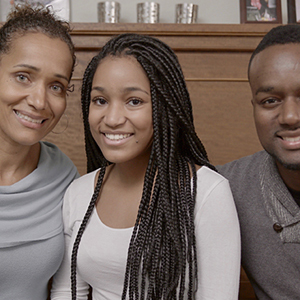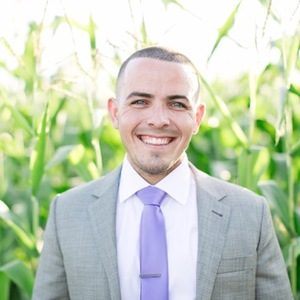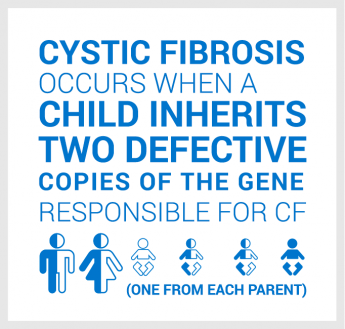With her sparkling eyes, gentle smile and joie de vivre, Tamy often leaves others in disbelief when they find out that she has cystic fibrosis. The doctors were even more surprised to see the screening tests come back positive when she was barely two years old because the disease is extremely rare among Haitians. However, she must still follow a very strict routine every day in order to stay in shape.
We met with Tamy, as well as her mother Nadia and one of her older brothers, Andy, so that they could tell us how the disease turned their lives upside down.
How did you react to finding out that Tamy had cystic fibrosis?
Nadia: It was a shock, but, at the same time, when you find out something like that, the adrenaline kicks in. The doctors told us it was unlikely because we were black, so they did the tests again. Tamy was almost two years old. She had the signs, but the doctors said I was worrying for nothing. Ouf! The emotions are all coming back! (Nadia pauses to gather her thoughts.) No one in the family had this disease. It’s a known illness, but as long as it doesn’t touch you, it doesn’t concern you. It only concerns others.
Andy, how did you react to finding out about the disease and its progression?
Andy: I was 11 years old. Adolescence is already a period of change and self-assertion, but, on top of that, we were moving from Longueuil to Saint?Hilaire. We hadn’t been in Longueuil very long, I was leaving all my friends and, at the same time, I found out my sister had cystic fibrosis. I didn’t know anything about it, but I discovered it was a colossal disease. My sister had been around for barely two years, I was still getting to know her and then I found out that she had a fatal illness. All our lives changed at that point, and the news hit us hard.
At the time, we were three kids at home, but it was always Tamy, Tamy, Tamy. Thierry was six years old, and my mother told me that I had to pay a lot more attention to him. Thierry and I stuck together because we knew the situation was serious. It’s the kind of situation that changes you and forces you to mature faster! (Nadia nods in agreement with her oldest son.)
Tamy, can you describe your daily routine with your treatments?
Tamy: I get up and, while I’m having breakfast, I take enzymes that allow me to digest things that I normally can’t. Then, I have to use a saline solution and apply cortisone in my nose twice a day because I have polyps. I do respiratory physiotherapy with a pump that helps to drain the mucus that blocks my bronchi to avoid getting pulmonary infections. When I have too much mucus in my lungs, I have trouble breathing and I cough a lot. I also take antibiotics using an inhaler, in the morning and at night. Afterwards, I exercise. It’s good for my muscles and joints because I have cystic fibrosis-related arthritis. I take digestive enzymes, vitamins, antioxidants and antacids when I eat. Also, every morning, I drink shakes that contain protein, fibre and laxatives.
But you’re still a young girl full of pep.
Tamy: Yes, cystic fibrosis is part of me, but I sometimes forget that I have it. It’s something that I have to live with permanently. When I get up to go to school, I feel like a person who doesn’t have a disease. I can do just as much as anyone else can. I go to parties. (Tamy laughs.) However, sometimes, I’m limited. When it comes to sports, I can’t do everything. I have more trouble breathing, and cardio is very hard for me.
If you could send a message to people who don’t know the disease to help them understand, what would you say?
Tamy: It’s important to understand that it isn’t a disease that shows. People often don’t believe I have it. They minimize cystic fibrosis. They think it just causes lung problems, but it’s much more than that. I have to eat more than others and make sure that my diet is rich in protein and high in calories to compensate for my dietary deficiencies. I also have to watch out for bacteria, for example, by not drinking tap water or using the hot tub, which would actually help my arthritis. I have treatments to administer every day, appointments at the hospital…
What do you mean by “minimize”?
Tamy: For example, if we’re running and I stop because I’m nauseous and feel like I’m about to throw up, some people think that it has nothing to do with cystic fibrosis. They think I just don’t train enough. Also, even though I tell people I don’t gain weight because of cystic fibrosis, they often say: “You eat and eat, but you never gain weight. You’re so lucky!” Yes, I’m lucky with my bad luck, but I have trouble gaining weight.
What do you mean by “lucky with your bad luck”?
Tamy: I’ve seen patients with more severe cases of cystic fibrosis than me who have to be fed intravenously. They end up in the hospital even more often. I’m lucky to be home. I go out with my friends, I go to restaurants, I work, I go to CEGEP and I can play sports, even though I’m limited.
In Quebec, there was no neonatal screening for cystic fibrosis before 2017. What do you think about that?
Nadia: Neonatal screening is very important. It makes it possible to start the treatments as soon as possible. The earlier the treatments start (whether they’re respiratory treatments or medications), the greater the chance of improving the patient’s state of health. Dr. Lands, Tamy’s pneumologist is very involved with this issue because the disease is quite common in Quebec. Many people carry it. In Lac-Saint-Jean, where I was born, 1 person out of every 15 is a carrier!
Do you have a message for people who would like to get involved?
Tamy: When you give to the cause of cystic fibrosis, it allows me to live longer. The lifespan of a person with the disease is now more than 53 years. It helps with research and is a source of hope for every child with cystic fibrosis.
Andy: I remember a doctor telling us, “Every year of research is a year added to the life of a patient with cystic fibrosis.” If we’re able to raise as much money as possible every year to find new ways to treat this incurable disease, we can at least find solutions to help these people live a bit longer.





